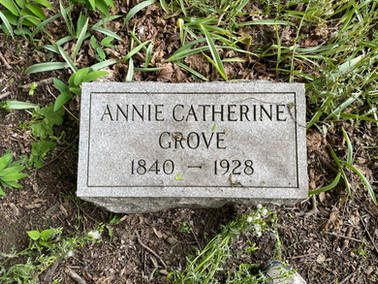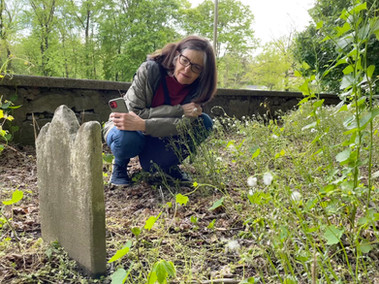God's Acre
- Karen L Kurtz
- Sep 30, 2023
- 6 min read
Updated: May 20, 2024

Local legends grow of their own accord, it seems. No one knows when or how it happens that old, isolated cemeteries become entangled with tales of ghost sightings or warnings of malevolent spirits who bring harm, (and even death) to daredevils and skeptics who scoff at them. Such legends were told of a quaint, stone-walled burial ground by the wide Susquehanna River near Marietta, Pennsylvania. Maps identify this cemetery as the “Hans Graf Graveyard.”

The internet had many eerie legends about this particular cemetery. Hans Graf was a werewolf, they said. A white ghost hound still guards the graves! The Graf family, after they were accused of being werewolves, were murdered by an angry mob on this spot and were buried here! The stories said the cemetery was still cursed. If you walk on the wall that encircles the graveyard seven times under a full moon, you will meet an untimely death before morning, they said. I visited this graveyard two days shy of a full moon, so I couldn’t put that legend to rest. ( I say with bravado.)
The stories piqued my interest. Not because I am a ghost-chaser, but because Hans Graf was my great(x 8)-grandfather.

When I visited the Hans Graf Graveyard in May I had this image of an old map. (I’ve inserted in a blue label where the cemetery was.) Around the corner, only a minute or two by foot, stands a building that had been a stone grist mill dating back to the mid-1700’s. It was still grinding flour, 8 barrels a day, until it closed in 1933. The Grove family, whose surname had been anglicized from the Swiss name, “Graf” (Graf > Groff > Grove), had owned the mill for thirty-four of those years. Later, the Schocks ran the mill for thirty-six. The surrounding village became known as “Schock’s Mills.”
There are both Schocks and Groves amongst the three- dozen folks buried in the cemetery. The inscriptions indicate that most had lived in the nineteenth century. The last burial, it seemed, was Annie Grove in 1928. I noticed there were no repeating death dates to give rise to the story that a mass murder had taken place here. It was a sobering thought, though, that as a descendant of Hans Graf I would also meet the requirements to be buried here. . . in this haunted acre.
The limestone plaque mortared into the wall that surrounds the graveyard reads: Within this God’s Acre rest the descendants of Hans Graf.

I paused over the words, “God’s Acre,” an archaic phrase I’d noticed was used in other graveyards of that era. Originally the term, acre, did not refer to a specific measurement of land. For a time, an acre was the amount of land a yoke of oxen could plow in a day. An even older meaning for acre referred simply to a field that was tilled, ready for planting. It was the older meaning that made sense of God’s Acre―hallowed ground, prepared for “planting.”

Hans Graf, himself, was not buried within this cemetery. (The first interments here happened more than fifty years after he died in 1746.) He was buried 28 miles away in the Mennonite Brick Church Cemetery, close to where he lived. His grave marker claims he was the “first settler” in that area, a lovely valley that came to be known as Graf’s Thal, or dell.
(See endnotes for Tx of the grave marker inscription.)
In Pennsylvania his name was usually spelled the way it was pronounced, “Groff,” though remnants of the Swiss spelling remain. He shows up often in Lancaster County history. Graf built the first grist mill in the county, and the town of Groffdale grew up around it. Earl Township in Lancaster County was also named for him in 1729. (Graf translates from German into English as “Earl,” a title bestowed upon him in Europe before he emigrated to Pennsylvania.) A family record mentions that into his elder years he was addressed as “der Graf”, the Earl.
Genealogical researchers and old family journals say that back in the 17th century young Hans Graf was from a family of wealth and prestige. He was exiled from Switzerland because he affiliated himself with the Anabaptist movement. Thousands, like Graf, had been forced to flee to other parts of Europe because of religious persecution of anabaptists in Switzerland. Graf escaped to the Alsace just north of the Swiss border. Eventually he migrated, likely with his wife and son, to Pennsylvania, where William Penn had begun his "Holy Experiment" fifteen years earlier.
Penn, the Quaker proprietor of Pennsylvania had been actively appealing to Swiss anabaptist refugees to settle there because of their knowledge of good farming techniques (crop rotation, particularly) and their pacifist principles. Penn had been advertising Pennsylvania as a utopia where people of any faith could worship as they pleased. And, indeed, people of all faiths lived together in these early Pennsylvania communities. The differences that separated them in Europe seemed to be set aside. Often different denominations shared the same worship services in the early communities. The immigrants also lived peacefully amongst the Lenni-Lenape Nations.
Graf’s family passed down stories about his early years. After the death of his first wife, he married Susanna Orndorff Kündig, and they raised their family of ten children in Pequea Valley. The story goes that his horses strayed away one night, and he tracked them to a wonderful little creek. He was so pleased with this spot that he built a log cabin there. The creek is still known as Groff’s Run.

Subsequently Hans and Susanna purchased 1400 acres from William Penn's sons. An 1855 map is illustrated with an artist’s image of the original homestead occupied by Levi Groff, a direct descendant of Hans and Susanna.

Recently, the Millersburg University Archaeology students spent two years excavating Hans Graf’s original cabin, as it was regarded the earliest of German immigrant dwellings in Lancaster County.
Graf was known to have become fluent in the indigenous language where he settled. He established a trading post with the tribes, likely the Shawnee who had migrated from Maryland to that area about the same time. Graf exchanged blankets for furs, which he took by covered wagon to Philadelphia and purchased manufactured goods to bring back for his trading post. Later, Graf was one of the men appointed to lay out the Kings Highway in 1733 from Lancaster to Philadelphia.
Graf seems to have been a man who gave back to the community named for him--Groffdale. From many accounts it seems he was a peaceful man, staying true to his anabaptist beliefs. He gave part of his farmstead for a Mennonite Church and cemetery where he and Susanna are buried along with many other descendants in his family. Generations of children and grandchildren carried forward the religious traditions he brought from Switzerland. It seems he was particularly generous in helping other Swiss Mennonite immigrants get settled in Pennsylvania.
I know that when he was an elderly man in 1731, Hans Graf paid the indenture fees for an eight-year-old Mennonite boy, Joseph Schenk Horst, whose father had died on the ship Britannia somewhere in the middle of the Atlantic. The boy grew up in the Graf household and married Hans Graf’s granddaughter, Mary. Joseph Horst and Mary Groff were given farmland from Hans Graf’s estate.
Six generations later—in a family lineage that seems so removed from werewolf legends―my mother’s father, my beloved grandpa―Jonas Horst, was born.

END NOTES:
1. Hans Graf grave-marker reads: “HANS GRAF, The first Settler, Came from Switzerland A.D. 1696. Settlement was made at the head of Groff's Run. He purchased 1419 Acres of land from John, Richard &Thomas Penn, for 141L. 18 S. along Groff's Run. He built a log Cabin on the old Groff farm A.D. 1717. His purchase included the land on which the Groffdale Meeting House is built. Died A.D. 1746.”
2. The Anabaptists ( or taufers in Swiss vernacular, which translates as "re-baptizers") were a rapidly growing group that separated from the Swiss Reformed Church in the 1520’s. They called themselves Swiss Brethren. However, the term"Anabaptists" became a negatively-charged, general label throughout Europe given to several "radical" religious groups who had some beliefs in common, especially the idea of adult baptism, rather than infant baptism. Swiss Anabaptists also believed in pacifism and felt that the state should not merge with the church and make final rulings on religious matters. The Swiss Reformed Church, which became a state church in major cantons of Switzerland, was instrumental in the heinous tortures, exiles, and death sentences for Anabaptists. The persecution continued more than 250 years. There have been reconciliation efforts extended to Anabaptists on behalf of the Swiss Reformed Church and Swiss government within recent years.
3. Although Hans Graf belonged to an Anabaptist group who called themselves the “Swiss Brethren,” other Europeans referred to them as “Mennonites” (which was actually a Dutch Anabaptist group started by Menno Simons in the Netherlands, circa 1536.) When the Swiss Brethren arrived in America, they were referred to as “Mennonites.” Today, those Mennonites who have Swiss roots often insist on being called “Swiss Mennonites” to distinguish their group from those who had followed Menno Simons in the Netherlands.
Acknowledgement:
I wish to acknowledge the original homelands of the Lenni-Lenape Nations whose thriving culture and villages existed where my ancestors settled and thrived. My family was part of the ever-westward expansion of European settlers. As I attempt to understand the history of my family, their persecution in Europe and their emigration to Pennsylvania to experience freedom, I continue to struggle to stay conscious of the impact my ancestors and I have had on the original peoples of this land.
~K L Kurtz













Comments